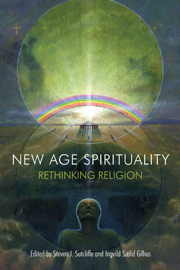Book contents
- Frontmatter
- Contents
- Introduction: “All mixed up” – thinking about religion in relation to New Age spiritualities
- Part I Rethinking New Age spiritualities
- Part II Comparing New Age beliefs and practices
- Part III Putting new spiritual practices to work
- 11 Beyond the spiritual supermarket: the social and public significance of New Age spirituality
- 12 From New Age to new spiritualities: secular sacralizations on the borders of religion
- 13 Cognitively optimal religiosity: New Age as a case study
- 14 Theorizing emotions in New Age practices: an analysis of feeling rules in self-religion
- 15 Doing things with angels: agency, alterity and practices of enchantment
- Conclusion: New Age spiritualities – “good to think” in the study of religion
- Contributors
- Further reading
- Bibliography
- Index
13 - Cognitively optimal religiosity: New Age as a case study
from Part III - Putting new spiritual practices to work
- Frontmatter
- Contents
- Introduction: “All mixed up” – thinking about religion in relation to New Age spiritualities
- Part I Rethinking New Age spiritualities
- Part II Comparing New Age beliefs and practices
- Part III Putting new spiritual practices to work
- 11 Beyond the spiritual supermarket: the social and public significance of New Age spirituality
- 12 From New Age to new spiritualities: secular sacralizations on the borders of religion
- 13 Cognitively optimal religiosity: New Age as a case study
- 14 Theorizing emotions in New Age practices: an analysis of feeling rules in self-religion
- 15 Doing things with angels: agency, alterity and practices of enchantment
- Conclusion: New Age spiritualities – “good to think” in the study of religion
- Contributors
- Further reading
- Bibliography
- Index
Summary
THE “MODES OF RELIGION” THEORY
In a number of well-known publications, Harvey Whitehouse proposes (2000, 2004a) that religious practices and concepts are transmitted by one of two fundamentally different modes: the imagistic and the doctrinal. The “modes of religion” theory has attracted considerable scholarly interest, and only the bare essentials need to be summarized here. The theory is based on the observation that religious elements, in order to survive, must be committed to memory, and that there are two distinct forms of memory with divergent properties that profoundly influence the nature of those religious elements.
Episodic memory stores single, salient events. We remember specific details from our last birthday or what we did when we heard of the attacks on the iconic date of 9/11. Semantic memory allows us to recall general knowledge, procedures and routines. This is what enables us to remember as a general fact that Moscow is the capital of Russia, and makes us able to easily recall what we usually eat for breakfast, whereas we presumably don't remember how we found out what the Russian capital is called, or what we specifically had for breakfast on a random day several years ago.
The sheer fact that religious concepts and ritual actions, like any other information, need to be stored in memory and recalled implies that religions are subject to the strictures inherent in each of the two memory types. Imagistic religiosity depends on single events with considerable emotional impact being stored in episodic memory.
- Type
- Chapter
- Information
- New Age SpiritualityRethinking Religion, pp. 212 - 226Publisher: Acumen PublishingPrint publication year: 2013



